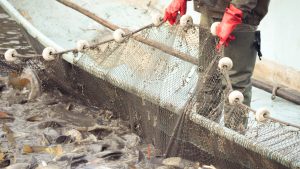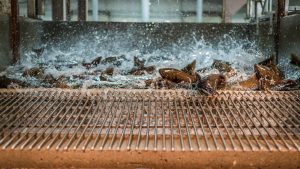For many, seafood is the cornerstone of a healthy diet. But as our reliance on the fish farming industry continues to grow, is enough being done to protect the welfare of aquatic animals?
The fish farming industry is thriving and the world’s appetite for seafood continues to grow. It is estimated that up to three trillion fish are killed for food each year, with some scientists predicting a collapse in fish stocks by 2048 if fishing continues at its current rate. Yet, while the industry strives to meet this growing demand for seafood, the welfare of aquatic animals can often suffer as a result.
According to the Aquatic Life Institute (ALI), aquatic animals represent the second largest category of animals killed each year, 15 times greater than that of land animals. With the aim of establishing robust welfare guidelines throughout the global seafood market by 2030, the Aquatic Life Institute is at the forefront of the aquatic welfare movement, facilitating essential coalitions across the fields of animal welfare, conservation and policy as well as promoting and funding essential research in order to improve the welfare of farmed fish on a global scale. The Innovation Platform spoke to the organisation’s COO, Rockwell Schwartz, about how the fish farming industry can sustainably evolve while preserving and respecting the welfare of aquatic animals.
The global consumption of fish has increased dramatically in recent years, what are the main issues associated with this in terms of aquatic animal welfare?
At the Aquatic Life Institute, we look at two main and overlapping areas of aquatic animal welfare. Firstly, the capture and killing of wild aquatic animals, which affects an estimated two to three trillion animals each year and is a relatively short but extremely high-suffering process. Secondly, we consider the complete lifecycle of farmed aquatic animals, from breeding the parent population through to hatching and rearing and slaughter, which varies depending on the species and the segment of the industry and affects approximately 100 billion animals each year. At the Aquatic Life Institute, we have worked with our NGO coalition partners to identify the top five welfare pillars we believe impact the lives of aquatic animals today and released a first-of-its-kind guide to these welfare pillars in December 2020. They include categories such as the environment animals are farmed in, which are typically barren, overcrowded, stressful, and inconducive to physical and psychological wellbeing.
ALI’s five main welfare considerations for aquatic animals are:
- Enriched environment: create an environment that meets species’ specific ethological needs analogous to their ideal habitat;
- Feed composition and feeding: reduce the amount of wild-caught fish required for aquaculture feed by researching alternative feed sources, improving feed conversion ratios, and substituting carnivorous farmed species with herbivorous species. Strive for the most optimal feeding times and quantities and avoid starvation periods exceeding 72 hours;
- Space requirements and stocking density: maintain appropriate space by species and life stage to avoid negative physical, psychological, and behavioural impacts;
- Water quality: key water quality indicators should be monitored continuously or at least once a day; and
- Stunning and slaughter: all animals must be effectively stunned before slaughter while the time elapsed between stunning and slaughter must be minimised in order to lower the risk of consciousness being recovered.

How do current welfare standards in fish production need to improve, particularly as the global demand for fish increases?
At the Aquatic Life Institute, we believe welfare is an integral component of sustainability and of 21st century aquaculture. Low welfare translates to stressed animals with compromised immune systems, who are in turn more susceptible to disease, which then creates increased reliance on antibiotic use by the industry and increased mass mortalities within farms. In recent years, we have seen an industry push toward aquatic animal farming as a ‘sustainable’ alternative to the capture of wild aquatic animals. However, not only does this trend create new and severe welfare problems, but it is also disingenuous in that 1.2 trillion wild aquatic animals are captured each year strictly to be fed to farmed animals. The so-called ‘blue loss’ represents the aquatic animals that are unaccounted for in the human food chain (see: https://ali.fish/blue-loss).
Aquatic animal farming today cannot exist without continued dependence on wild populations at a great scale. We believe that the aquaculture industry is highly adaptable and bursting with innovation and we want to see that energy channelled toward production that is genuinely sustainable and humane, drawing on the latest research in animal behaviour, fish psychology, and on-farm studies.
What are the challenges in implementing and regulating legal frameworks for the welfare of farmed aquatic animals on a global scale?
Aquaculture is a truly global industry and there are widely recognised problems with transparency and traceability. This March, there was widespread media coverage of a new study that looked at 30 countries and found 36% of seafood was mislabelled. We believe this is of grave concern not just to those concerned with animal welfare and conservation, but also all consumers, who have the right to know that what they are buying, and eating, is what the label clarifies. Internationally, governments, producers, and certifying bodies must mandate stronger standards, consistent record-keeping, and public reporting to ensure transparency and public access to truthful information.
What are the environmental impacts of poorly managed aquaculture? For instance, if water quality is poorly managed?
Aquaculture impacts the environment in numerous significant, frequent, and sometimes irreversible ways. Each year, 1.2 trillion wild aquatic animals are captured to be fed to farmed animals, with the majority of those being farmed aquatic animals. This wreaks havoc on wild populations, leads to additional abandoned fishing gear (‘ghost gear’) in our oceans, and disrupts natural ecosystems. Farmed aquatic animals are often confined adjacent to areas frequented by wild animals, leading to disease and parasite transference between the two, and sometimes crossbreeding, which can affect the genetics of wild populations. Some local species may also prey on the captive aquaculture animals and aquaculture producers may kill them as a result; this can include endangered species. Additionally, the waste from aquaculture production can pollute surrounding areas, similar to that of terrestrial animal farming. Unfortunately, despite popular belief, aquaculture has a hefty environmental footprint.

What are the ALI’s main objectives in trying to improve aquatic animal welfare? What do you hope the Aquatic Animal Alliance initiative will achieve?
We believe that animal welfare is an integral component of improved aquaculture production and aquaculture innovation in the years ahead can and should incorporate welfare. Higher welfare means better production for both the aquatic animals and the producers. The Aquatic Life Institute joined forces in 2020 with the veterinarian-led Center for Aquatic Animal Research & Management on a first-of-its-kind pilot study on aquaculture producer sentiments on animal welfare (see: www.well.fish). Overwhelmingly, producers are on board with improving welfare but can use more direction from researchers and NGOs on how to actually do so. We believe ALI and the Aquatic Animal Alliance can play a pivotal role during this crucial moment in providing research-backed recommendations that are actionable for producers and will create meaningful change for animals in aquaculture.
Catalina Lopez
Director of the Aquatic Animal Alliance
Aquatic Life Institute
Tweet @aquaticlifeins
https://ali.fish/
Please note, this article will also appear in the sixth edition of our quarterly publication.







